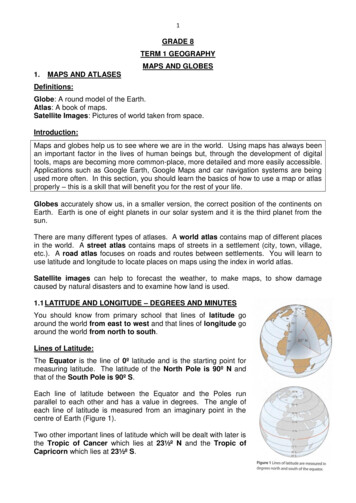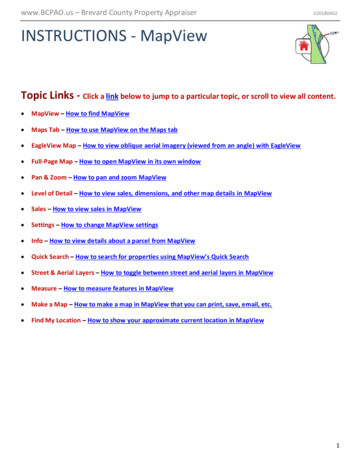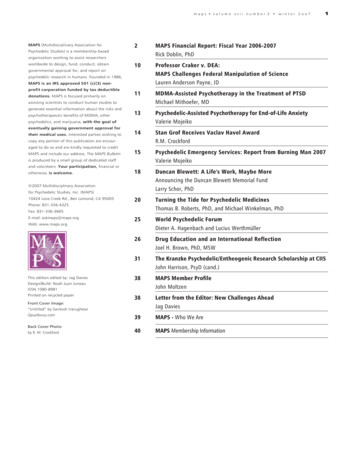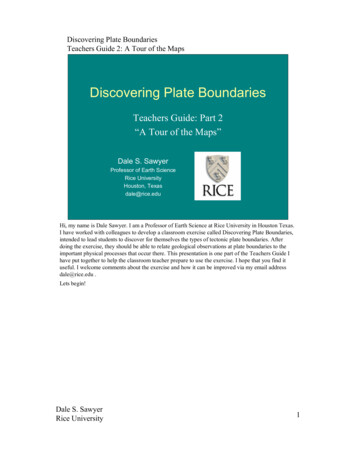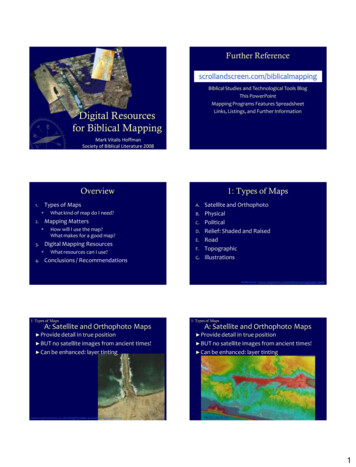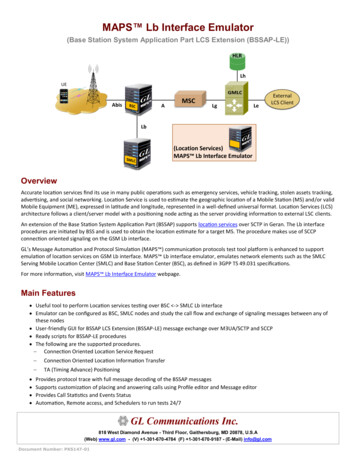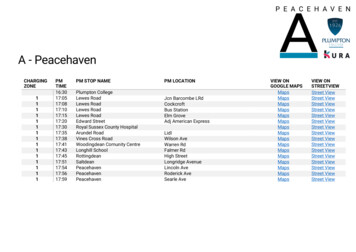
Transcription
AVAILABILITY OF BOOKS AND MAPS OF THE U.S. GEOLOGICAL SURVEYInstructions on ordering publications of the U.S. Geological Survey, along with prices of the last offerings, are given in thecurrent-year issues of the monthly catalog "New Publications of the U.S. Geological Survey." Prices of available U.S. GeologicalSurvey publications released prior to the current year are listed in the most recent annual "Price and Availability List." Publicationsthat are listed in various U.S. Geological Survey catalogs (see back inside cover) but not listed in the most recent annual "Priceand Availability List" are no longer available.Prices of reports released to the open files are given in the listing "U.S. Geological Survey Open-File Reports," updatedmonthly, which is for sale in microfiche from the U.S. Geological Survey, Books and Open-File Reports Section, Federal Center,Box 25425, Denver, CO 80225. Reports released through the NTIS may be obtained by writing to the National TechnicalInformation Service, U.S. Department of Commerce, Springfield, VA 22161; please include NTIS report number with inquiry.Order U.S. Geological Survey publications by mail or over the counter from the offices given below.BY MAILOVER THE COUNTERBooksBooksProfessional Papers, Bulletins, Water-Supply Papers, Techniques of Water-Resources Investigations, Circulars, publications ofgeneral interest (such as leaflets, pamphlets, booklets), single copies ofEarthquakes & Volcanoes, Preliminary Determination of Epicenters,and some miscellaneous reports, including some of the foregoing seriesthat have gone out of print at the Superintendent of Documents, areobtainable by mail fromBooks of the U.S. Geological Survey are available over thecounter at the following U.S. Geological Survey Public InquiriesOffices, all of which are authorized agents of the Superintendent ofDocuments:U.S. Geological Survey, Books and Open-File ReportsFederal Center, Box 25425Denver, CO 80225Subscriptions to periodicals (Earthquakes & Volcanoes andPreliminary Determination of Epicenters) can be obtained ONLY fromtheSuperintendent of DocumentsGovernment Printing OfficeWashington, D.C. 20402(Check or money order must be payable to Superintendent ofDocuments.)WASHINGTON, D.C.-Main Interior Bldg., 2600 corridor,18th and C Sts., NW.DENVER, Colorado-Federal Bldg., Rm. 169, 1961 Stout St.LOS ANGELES, California -Federal Bldg., Rm. 7638, 300 N.Los Angeles St.MENLO PARK, California-Bldg. 3 (Stop 533), Rm. 3128, 345Middlefield Rd.RESTON, Virginia-503 National Center, Rm. 1C402, 12201Sunrise Valley Dr.SALT LAKE CITY, Utah-Federal Bldg., Rm. 8105, 125 SouthState St.SAN FRANCISCO, California Customhouse, Rm. 504, 555Battery St.SPOKANE, Washington-U.S. Courthouse, Rm. 678, West 920Riverside Ave.ANCHORAGE, Alaska-Rm. 101, 4230 University Dr.ANCHORAGE, Alaska-Federal Bldg., Rm. E-146, 701 C St.MapsFor maps, address mail orders toU.S. Geological Survey, Map DistributionFederal Center, Box 25286Denver, CO 80225Residents of Alaska may order maps fromAlaska Distribution Section, U.S. Geological SurveyNew Federal Building - Box 12101 Twelfth Ave., Fairbanks, AK 99701Cover design by Nancy Polend, 1991MapsMaps may be purchased over the counter at the U.S. GeologicalSurvey offices where books are sold (all addresses in above list) and atthe following U.S. Geological Survey offices:ROLLA, Missouri 1400 Independence Rd.DENVER, Colorado Map Distribution, Bldg. 810, FederalCenterFAIRBANKS, Alaska-New Federal Bldg., 101 Twelfth Ave.
Introduction:Enewetak Atolland the PEACE ProgramBy THOMAS W. HENRY and BRUCE R. WARDLAWGEOLOGIC AND GEOPHYSICAL INVESTIGATIONS OF ENEWETAK ATOLL,REPUBLIC OF THE MARSHALL ISLANDSU.S. GEOLOGICAL SURVEY PROFESSIONAL PAPER 1513-AA compilation of studies originating from thePacific Enewetak Atoll Crater Exploration(PEACE) Program, prepared in cooperationwith the Defense Nuclear AgencyUNITED STATES GOVERNMENT PRINTING OFFICE, WASHINGTON: 1990
U.S. DEPARTMENT OF THE INTERIORMANUEL LUJAN, Jr., SecretaryU.S. GEOLOGICAL SURVEYDallas L. Peck, DirectorAny use of trade, product, or firm names in this publication is fordescriptive purposes only and does not imply endorsement by theU.S. GovernmentLibrary of Congress Cataloging in Publication DataIntroduction : Enewetak Atoll and the PEACE Program / Thomas W. Henry and Bruce R. Wardlaw.p. cm.(Geologic and geophysical investigations of Enewetak Atoll, Republic of the Marshall Islands ; ch. A) (U.S. GeologicalSurvey professional paper ; 1513-A)"A compilation of studies originating from the Pacific Enewetak Atoll Crater Exploration (PEACE) Program, prepared incooperation with the Defense Nuclear Agency."Includes bibliographical references.Supt.ofDocs.no.: I 19.16: 1513-A1. Geology Marshall Islands Enewetak Atoll. 2. Geophysics Marshall Islands Enewetak Atoll. 3. Pacific EnewetakAtoll Crater Exploration Program. I. Henry, Thomas W. II. Wardlaw, Bruce R. III. Pacific Enewetak Atoll CraterExploration Program. IV. Title: Introduction: Enewetak Atoll and the PEACE Program. V. Series. VI. Series: U.S.Geological Survey professional paper ; 1513A.QE349.M35I58199090 3314559.68'3-dc20CIPFor sale by the Books and Open-File Reports Section, U.S. Geological Survey,Federal Center, Box 25425, Denver, CO 80225
CONTENTSPageAbstract. AlGeneral Remarks.1Basic Problem.3Pacific Proving Grounds and Enewetak Nuclear Testing .5Objectives of PEACE Program.5Roles, Data Bases, and Data Acquisition.5Pre-PEACE Program Data Bases .7Preparatory Onsite Work.8Marine Phase of PEACE Program .8Drilling Phase of PEACE Program. 10PEACE Program Reports. 10Current Series of Papers . 12Acknowledgments. 12Location and Setting. 16Previous Geologic Investigations. A16Studies from 1946 to 1952 . 16First Atoll Boreholes. 17AEC-LASL Drilling Program (1950-1951). 18USGS-AEC Drilling Program (1951-1952). 18Interim Period (1952-1970). 21Air Force Weapons Laboratory Studies (1970-1981). 21PACE Program (1970-1972). 21EXPOE Program (1973-1974). 21EASI Program (1979-1981). 24Interim Events (1981-1984) Leading to PEACEProgram. 25References Cited. 25ILLUSTRATIONSFIGURE1.2.3.4.5, 6.Index and geographic maps of the Republic of the Marshall Islands. A2Map of Enewetak Atoll, Republic of the Marshall Islands.3Graph showing dimensions of explosion and impact craters .4Map showing sites of detonations on Enewetak Atoll.7Photographs of:5. DOE research vessel Egabrag II and MARFAB, Inc's, two-man submersible Delta .96. 237-foot-long drill ship Knut Constructor. . 117. Maps of KOA and OAK crater areas showing borehole sites and general bathymetric contours. 128. Photograph of drill ship H.M.S. Porpoise.9, 10. Maps of Enewetak Atoll showing locations of:9. AEC-LASL (1950-1951) boreholes.10. USGS-AEC (1951-1952) deep boreholes .11. Chart showing correlation of USGS-AEC deep boreholes drilled on Enewetak and Bikini Atolls .12, 13. Maps of Enewetak Atoll showing locations of:12. PACE Program (1970-1972) boreholes .13. EXPOE Program (1973-1974) boreholes.14. Subsurface geologic cross section of Enjebi Island.17181920222324TABLESTABLE 1.2.3.4.Dates and locations of nuclear detonations on Enewetak Atoll. A6Downhole geophysical logs from PEACE Program drilling . 13Summary of PEACE Program borehole data from KOA and OAK craters . 14Summary of reports from the PEACE Program . 15
IVCONTENTSMETRIC CONVERSION FACTORSFor readers who wish to convert measurements from the inch-pound system of units to the metricsystem of units, the conversion factors are listed below:Multiply inch-pound unitsfoot (ft)nautical mile (nmi)1nautical mile2 (nmi2)1By0.30481.8523.430To obtain metric unitsmeter (m)kilometer (km)kilometer2 (km2)1U.S. nautical mile.ALTITUDE DATUMSea level: The term "sea level" generally refers to the National Geodetic Vertical Datum of 1929(NGVD of 1929) a geodetic datum derived from a general adjustment of the first-order level nets ofboth the United States and Canada, formerly called Sea Level Datum of 1929. The tidal datum usedin this report was established in 1952 during Operation IVY jointly by the U.S. Coast and GeodeticSurvey and Holmes and Narver, Inc. (H&N). The datum used is 0.5 ft below the mean-lowwater-spring-tide level (MLWS), which is the datum used on the navigation charts of Enewetak Atollproduced by the U.S. Navy Hydrographic Office. Individual tidal datums for several of the northernislands were established in 1951 and 1952 by Holmes and Narver. These datums are 0.5 ft belowapproximate-mean-low-water-spring tide (AMLWS). In this report, "sea level" refers to the AMLWSdatum of 1951-52, also called the H&N datum.
GEOLOGIC AND GEOPHYSICAL INVESTIGATIONS OF ENEWETAK ATOLL,REPUBLIC OF THE MARSHALL ISLANDSINTRODUCTION: ENEWETAK ATOLL AND THE PEACE PROGRAMBy THOMAS W. HENRY and BRUCE R. WARDLAWand 8.9-megaton (Mt)-yield detonations on May 12 andJune28, 1958, respectively, near the northern perimeterAn extensive study was made from June 1984 through August 1985ofEnewetaklagoon. At that time, Enewetak was adminof the surface and subsurface configurations of two large nuclearcraters on the northern side of Enewetak Atoll, Republic of the istered by the U.S. Government through the TrustMarshall Islands. These craters, KOA and OAK, resulted from the Territories of the Pacific Islands and was part of thenear-surface detonation of two high-yield thermonuclear devices in Pacific Proving Grounds (PPG), where, on remote atolls1958, when the atoll was part of the Pacific Proving Grounds. Thismultidisciplinary study was designed to produce a broad, well- and islands from 1946 through 1962, atmospheric nucleardocumented geologic, geophysical, and materials-properties data base testing was carried out. KOA and OAK are among thefor use in answering critical questions concerning craters formed by few craters produced by high-yield, near-surface burstshigh-yield bursts. The study was part of a larger research initiative bythat are available for study.the U.S. Department of Defense to better understand high-yield,Few sedimentary geologic environments are morestrategic-scale nuclear bursts and how Pacific Proving Grounds cratersrelate to the basing and targeting of nuclear-weapon systems and heterogeneous than a coral atoll. An analogy between arelated national defense issues.Pacific atoll and an inverted bucket filled with sedimentThe data gathered during the study of the Enewetak craters are is appropriate. The reef facies is the hard, competent,applicable to many scientific topics well beyond cratering mechanicscemented exterior formed by an organic frameworkand other related strategic concerns of the Department of Defense.These scientific topics include the geologic evolution of the Pacific dominated by coralline algae and corals. The backreefBasin, the biologic and geologic history of a coral atoll, the fluctuation environment, where the islands are generally located,of sea level in response to glaciation and deglaciation, the diagenetic consists of a spectrum of carbonate materials ranginghistory of carbonate rocks in relation to sea-level changes and thediffering substrate-water geochemistries thus produced, the speciation from uncemented to well cemented. Here, a group ofand migration of marine biotas, and the biostratigraphic succession of generally inorganic (marine) processes acts to cementbiotas through time and the calibration of these events with an absolute the sediment in selected areas to form what generally isisotopic time scale, to name a few. The objective of this U.S. Geological referred to as "beachrock." Thus, the reef and backreefSurvey Professional Paper series is to provide a forum for theseenvironments are the hard rim of the bucket. The bucketstudies.is filled with finer grained, lagoonal sediment that generally is much less cemented or uncemented and consequently is less competent than the rim. Also scatteredGENERAL REMARKSthroughout the lagoon of any atoll the size of EnewetakFrom mid-1984 through mid-1985, the U.S. Geological are numerous patch or pinnacle reefs. These lagoonalSurvey (USGS) conducted geologic and geophysical reefs are structurally competent edifices. However,investigations of two craters formed by the detonation of within the material inside the bucket (that is dominatedhigh-yield, near-surface nuclear devices at Enewetak by the finer grained sediment) are layers that have beenAtoll in the Marshall Islands (figs. 1, 2). These investi- more or less cemented by postdepositional nonmarinegations are collectively referred to as the Pacific (ground water) geochemical processes during periods ofEnewetak Atoll Crater Exploration (PEACE) Program. atoll emergence. These periods of emergence wereThe craters studied, KOA and OAK, resulted from 1.4- believed to have resulted from global lowstands of sealevel during glacial periods. These cemented layersManuscript approved for publication February 27, 1990.extend some distance inward toward the middle of theABSTRACTAl
A2GEOLOGIC AND GEOPHYSICAL INVESTIGATIONS OF ENEWETAK ATOLL140 180 140 VMARSHALL ISLANDSi HAWAIIINDEX MAP160 172 168 164 16' iI050100150200250300 NAUTICAL MILESJ I I I I IIIIIII50 100 150 200 250 300 KILOMETERSPACIFIC12'.-Toangi AtollREPUBLIC OF THEMARSHALL ISLANDSOCEAN " Bikini Atoll,.-." . Enewetak Atoll\z . Ujelang Atoll\-: .--.x.Kwajalein - Atoll\ %\ Majuro.Atoll ' \FEDERATED STATESOF MICRONESIAKosrae\REPUBLICOF NAURUGILBERT ISLANDS(UK)MakinAtollFIGURE 1. Index map showing location of the Marshall Islands in the Pacific Ocean and geographic map of the Republic of the Marshall Islands.
INTRODUCTION: ENEWETAK ATOLL AND THE PEACE PROGRAM162 162 101Teiteiripucchi (GENE)Elugelab (FLORA)H 40'A3162 30'162 20'IIVY /*" 160000GRID'(FT)Boken (IRENE)Enjebi (JANET)Bokinwotme (EDNA)Louj (DAISY)Kirunu (CLARA)Bokombako (BELLE)Bokoluo (ALICE)Mijikadrek (KATE)Kidrinen (LUCY)Bokeneiab (MARY)Elle (NANCY)Aej (OLIVE)Lujor (PEARL)Eleleron (RUBY)Aomon (SALLY)Bijile (TILDA)Lojwa (URSULA)-Alerrbel (VERA)Billae (WILMA)PREVAILING WIND 120000Runit (YVONNE)"M- (ZONA)11 "SO1nedrol (ALVIN) 80000Anaij (BRUCE)dimini (CLYDE)Biken (LEROY)Japtan (DAVID)EAST (DEEP) CHANNELMedren (ELMER) 40000Kidrenen (KEITH)Ribewon (JAMES)Boken (IRWIN)Mut (HENRY)Ikuren (GLENN)5 NAUTICAL MILES010,000l.lllllllllEnewetak (FRED)30,00050,000 FEETi0I10 KILOMETERSFIGURE 2. Enewetak Atoll, Republic of the Marshall Islands, with locations of principal islands and other features (native names followed bymilitary site names in parentheses), OAK, KOA, and MIKE craters, and MACK and OSCAR pinnacles. Jieroru is a small sand island insidethe East Channel that was not given a site name. Magnetic declination (1948) shown in compass.lagoon. This was the environment in which many of thehigh-yield, near-surface PPG nuclear bursts were detonated.BASIC PROBLEMPrior to the PEACE Program, the craters formedfrom near-surface bursts in the PPG were thought todiffer in several critical ways from craters produced byboth high-explosive and low-yield nuclear bursts in drytest beds at the Nevada Test Site1 or, for that matter,elsewhere. The craters produced by high-yield bursts inthe PPG were all formed in wet carbonate substrates.They have saucer-shaped apparent-crater profiles thatare extraordinarily broad and shallow. The apparentlrThese are generally referred to as continental United States (CONUS) sites.
A4GEOLOGIC AND GEOPHYSICAL INVESTIGATIONS OF ENEWETAK ATOLLEXPLANATION10 1 fl-NE HEx Dry soil*A Soft rockvv Hard rock40 Wet soil/wet soft rockIMPACT CRATERSn MoonMercuryPacific Proving Grounds craters* Terrestrial10 :10*10'10 :10-10 110 101102103DIAMETER (km)FIGURE 3. Dimensions of explosion and impact craters (from Cooper, 1977). NE, nuclear explosive; HE, high-yield explosive.craters2 resulting from these high-yield PPG bursts havehigh aspect ratios3 and, consequently, large volumes.The data base for PPG craters was extremely small and,because of the remoteness of the PPG and politicalconsiderations, difficult to augment. In contrast, theCONUS craters, for which a large data base was easilyobtained and easily expanded, have bowl-shapedapparent-crater profiles that are small and proportionally deeper. These apparent craters have low aspectratios and proportionally small volumes. In this sense,the CONUS craters are more similar to some impact(meteor) craters than to the PPG craters (see fig. 3).Research in the PPG undertaken in the 1970's, principally by the Defense Nuclear Agency (DNA), suggestedthat geologic and hydrologic environments influence latetime cratering processes and, therefore, play a funda-2Apparent crater is the locus of the zero-difference contour line surrounding acrater that is, the locus of points along which the effects of an explosion can nolonger be detected when the preevent contours are compared with the posteventcontours (B.L. Ristvet, pers. commun., 1986).3Aspect ratio is the ratio of crater depth to radius; the PPG craters typicallyhave aspect ratios of about 3:5, CONUS craters, 1:2.mental role in determining the final morphology and sizeof a crater (Knowles and Erode, 1977; Ristvet andothers, 1978; Erode, 1979). To quote Cooper (1977, p.20), "In general, the variation in cratering efficiencyappears to correlate with media strength, i.e., theweaker the medium, the larger the crater." It wassuggested that processes operating in response to thewater-saturated, "weak" geologic substrates wereresponsible for significant "late-stage" modifications ofthe PPG craters and that the aspect ratios of theexcavational craters (not the final apparent craters)resulting from PPG high-yield bursts were in fact muchcloser to aspect ratios predicted by first principle calculations and to aspect ratios at CONUS sites.Computational models capable of simulating a widevariety of phenomena associated with high-explosive andlow-yield nuclear bursts were available by the late1970's. However, to summarize, the PPG craters (asobserved and measured) formed by high-yield bursts andscaled to their CONUS counterparts were anomalous inshape and volume and could not be modeled confidently(Cooper, 1977; Knowles and Erode, 1977). The markeddifference in crater volume between the predictions from
INTRODUCTION: ENEWETAK ATOLL AND THE PEACE PROGRAMA5modeling and observations of existing PPG craters aOBJECTIVES OF PEACE PROGRAMdifference in the realm of an order of magnitude and theThe PEACE Program was a broad research initiativelack of confidence in the fundamental data base itselfresulted in considerable uncertainty about the Defense formulated by the DNA for the U.S. Department ofcommunity's ability to predict the effectiveness of Defense (DOD) to answer a number of key questionsnuclear weapons against targets and the attendant capa- about the dynamic properties of strategic-scale nuclearbility of strategic installations to functionally survive a bursts and the relevance of the large craters of the PPGnuclear burst. Of particular concern were hardened, to strategic issues. The multidisciplinary study of KOAand OAK craters conducted by the USGS on Enewetakunderground installations.was part of the PEACE Program. These two craterswere selected because of their accessibility and theirPACIFIC PROVING GROUNDS ANDdiffering source characteristics (see section on "InterimENEWETAK NUCLEAR TESTINGEvents (1981-1984) Leading to PEACE Program").The specific objectives of the DOD for the USGSThe U.S. Government conducted atmospheric nuclearportion of the PEACE Program were (1) formulation oftests in the Pacific from 1946 through 1962, before thea geologic and geophysical framework for the stratiLimited Test-Ban Treaty of 1963 mandated that allgraphic section (substrate or "test beds") in which thefurther testing of nuclear weapons be conductedcraters were formed, (2) identification and description ofunderground4. Enewetak and Bikini Atolls together concrater morphology, physiography, and structure, andstituted the western part of the PPG, which was createdmeasurement of the dimensions of primary crater feain 1948. The PPG, Amchitka in the Aleutian Islands, andtures, (3) acquisition of new material-properties dataPahute Mesa on the Nevada Test Site were the only sitesfrom the PPG substrates, and (4) better understanding ofwhere the U.S. Government tested megaton-rangethe processes that both formed the excavational craternuclear devices. After the residents of Enewetak andand altered that early-stage feature to the craterBikini Atolls were moved to nearby atolls, nuclear shotsobserved today (that is, the apparent crater). Establishwere conducted from 1946 through 1958 26 on Bikiniment of a geologic framework in which to place the newAtoll and 43 on or in the vicinity of Enewetak AtollPPG material-properties data was extremely important(Hines, 1962; Defense Nuclear Agency, 1981; Bliss,to the DNA for effective testing of computational mod1982). On October 31, 1958, the United States and theeling of a high-yield nuclear event (code validation). AsSoviet Union began a joint moratorium on atmosphericstated simply by Cooper (1977, p. 14), the larger of twotesting of nuclear weapons. In fall 1961, however, themain sources of error in simulating high-yield nuclearSoviets resumed atmospheric nuclear testing. Theevents is the "state-of-ignorance of the dynamic responseUnited States responded in 1962 with a series of 34of geologic media."nuclear tests in the vicinity of Johnston Atoll and Christmas Island in the central Pacific and 4 low-yield tests atthe Nevada Test Site.ROLES, DATA BASES, AND DATA ACQUISITIONThe first PPG nuclear tests were conducted on BikiniAtoll in 1946 during Operation CROSSROADS. The firstEnewetak Atoll lies in a geographically highly remotenuclear test on Enewetak Atoll was on April 14, 1948, as area. Successful operation of any large-scale researchpart of Operation SANDSTONE, a three-shot program program in such an area requires careful thought andstaged from 200-foot (ft)-tall, island-based towers. The planning. Acquisition of data from Enewetak and thetests on Enewetak were primarily weapons related, logistics were a collaborative effort between the USGS,although attempts were made to understand explosion the DNA, the U.S. Department of Energy (DOE), otherphenomena and the blast effects on various types of Federal agencies, private contractors and research labmanmade structures. Additional studies were conducted oratories, personnel from several universities, officials ofto measure biologic exposure and responses, to evaluate the newly formed Republic of the Marshall Islandsdetection instruments, to compare nuclear-yield deter- (RMI), and the people of Enewetak.minations, and so forth (Bliss, 1982, p. 1).The USGS conducted the geologic, paleontologic, andTable 1 lists the nuclear tests conducted on Enewetak geophysical investigations of OAK and KOA and workedAtoll. All but three of the Enewetak detonations closely with DNA contractors on analysis of the downoccurred on or in the vicinity of the northeastern band of hole geophysical logging, on the borehole gravimetry,islands on the atoll (fig. 4).and on parts of the other material-properties studies. Asoriginally planned, all field operations on Enewetak weretobe conducted concurrently. However, the fieldwork4The Limited Test-Ban Treaty did allow near-surface nuclear explosions forpeaceful purposes, such as excavations for harbors and canals.later was divided into two major phases, the Marine
A6GEOLOGIC AND GEOPHYSICAL INVESTIGATIONS OF ENEWETAK ATOLLTABLE 1. Dates and locations of nuclear detonations on Enewetak Atoll[ft, feet; kt, kiloton; Class., classified; Mt, megaton. 1 Mt 1,000 kt]EventnameDateBurst type/heightYieldGenerallocation1IVY-grid coordinatesX-RAYYOKEZEBRA1948Apr. 14Apr. 30May 14Tower, 200 ftTower, 200 ftTower, 200 ft37 kt49 kt18 ktJANETSALLYYVONNE147,330 N.130,907 N.106,120 N.083,569 E.111,993 E.124,364 E.DOGEASYGEORGEITEM1951Apr. 7Apr. 20May 8May 24Tower,Tower,Tower,Tower,Class.47 52Oct. 31Nov. 15SurfaceAirdrop, 1,500 ft210.4 Mt500 ktFLORAYVONNE147,754 N.108,150 N.067,789 E.124,130 E.NECTAR1954May 13Barge1.69 MtMIKE crater area147,750 N.067,790 CAMOHAWKAPACHEHURON1956May 4May 27May 30June 6June 11June 13June 16June 21July 2JulySJuly 21SurfaceTower, 200Tower, 300SurfaceTower, 200Tower, 300AirdropTower, 200Tower, 300BargeBarge40 ktClass.Class.13.7 , N. endSALLYYVONNEIRENEYVONNESALLYYVONNEPEARLRUBYMIKE crater areaMIKE crater DSCAEVOLAPISONIAOLIVEPINEQUINCEFIG1958May 5May 11May 12May 16May 20May 26May 26May 30June 2June 8June 14June 18June 27June 28July 1July 5July 14July 17July 22July 26Aug. 6Aug. 18SurfaceBargeSurfaceUnderwater, 500 rgeBargeLCULCUBargeBargeLCUBargeSurfaceSurface18 ktClass.2 1.37 Class.Class.28.9 YVONNESW. of YVONNEGENEHENRY, oceansideSW. of YVONNESW. of JANETSW. of YVONNESW. of JANETSW. of YVONNEN. of GLENNSW. of JANETSW. of YVONNESW. of JANETSW. of ALICESW. of YVONNESW. of JANETSW. of YVONNEW. of YVONNESW. of JANETSW. of JANETYVONNE, middleYVONNE, ,981101,871145,135102,638103,212145, 0076, .E.E.E.E.E.locations shown in figure 4.2Thermonuclear device.3Shot 5 ft off bottom in 150 ft of E.E.
A7INTRODUCTION: ENEWETAK ATOLL AND THE PEACE PROGRAM162 10'162 162 20'162 30'IVY / 160000GRID ZEBRAJ DOGi] CACTUSILACROSS 120000f BLACKFOOTJ FIG] QUINCELOSAGERunit (YVONNE)(OSCAR)HOLLYMAGNOLIALINDENSEQUOIA ]IfJ 80000SOUTHWESTPASSAGEEAST (DEEP) CHANNEL 40000WAHOO5 NAUTICAL MILES0Enewetak (FRED)10,00030,00050,000 FEET10 KILO METERSI.MlllMllFIGURE 4. Sites of detonations on Enewetak Atoll. Detonations having the same or approximately the same ground-zero location are groupedwith brackets. Generally, large asterisks indicate thermonuclear bursts, and small asterisks nonthermonuclear nuclear detonations.Phase and the Drilling Phase. The Marine Phase consisted of geophysical and geologic investigations of surface and subsurface characteristics of the two craters andenvirons. The Drilling Phase consisted of complementarygeologic and geophysical assessments of borehole data.PRE-PEACE PROGRAM DATA BASESA wide array of pre-PEACE Program data from thePPG was reexamined during the USGS studies. Includedwere the following:
A8GEOLOGIC AND GEOPHYSICAL INVESTIGATIONS OF ENEWETAK ATOLL1. Published accounts in the USGS Profes
(NGVD of 1929) a geodetic datum derived from a general adjustment of the first-order level nets of both the United States and Canada, formerly called Sea Level Datum of 1929. The tidal datum used in this report was established in 1952 during Operation IVY jointly by the U.S. Coast and Geodetic Survey and Holmes and Narver, Inc. (H&N).

